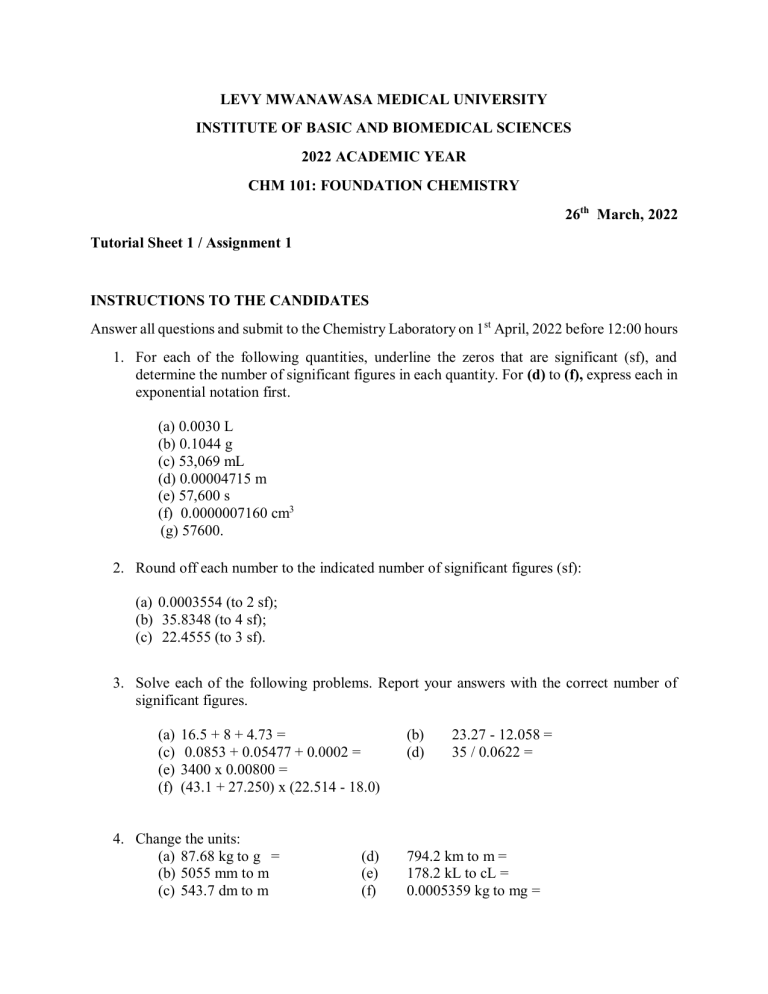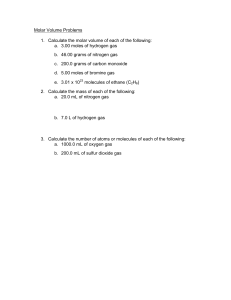CHM 101 Chemistry Tutorial: Significant Figures, Stoichiometry, Gas Laws
advertisement

LEVY MWANAWASA MEDICAL UNIVERSITY INSTITUTE OF BASIC AND BIOMEDICAL SCIENCES 2022 ACADEMIC YEAR CHM 101: FOUNDATION CHEMISTRY 26th March, 2022 Tutorial Sheet 1 / Assignment 1 INSTRUCTIONS TO THE CANDIDATES Answer all questions and submit to the Chemistry Laboratory on 1st April, 2022 before 12:00 hours 1. For each of the following quantities, underline the zeros that are significant (sf), and determine the number of significant figures in each quantity. For (d) to (f), express each in exponential notation first. (a) 0.0030 L (b) 0.1044 g (c) 53,069 mL (d) 0.00004715 m (e) 57,600 s (f) 0.0000007160 cm3 (g) 57600. 2. Round off each number to the indicated number of significant figures (sf): (a) 0.0003554 (to 2 sf); (b) 35.8348 (to 4 sf); (c) 22.4555 (to 3 sf). 3. Solve each of the following problems. Report your answers with the correct number of significant figures. (a) (c) (e) (f) 16.5 + 8 + 4.73 = 0.0853 + 0.05477 + 0.0002 = 3400 x 0.00800 = (43.1 + 27.250) x (22.514 - 18.0) 4. Change the units: (a) 87.68 kg to g = (b) 5055 mm to m (c) 543.7 dm to m (d) (e) (f) (b) (d) 23.27 - 12.058 = 35 / 0.0622 = 794.2 km to m = 178.2 kL to cL = 0.0005359 kg to mg = 5. Lithium is a soft, gray solid that has the lowest density of any metal. It is an essential component of some advanced batteries, such as the one in your laptop. If a small rectangular slab of lithium weighs 1.49 x 10 3 mg and has sides that measure 20.89 mm by 11.1 mm by 11.899 mm, what is the density of lithium in g/cm3 ? 6. Consider the following archery targets: Comment the results in terms of accuracy and precision of the archery targets A, B and C. 7. Chlorine has two naturally occurring isotopes: chlorine-35 and chlorine-37. The mass of an atom of chlorine-35 is 5.807 x 10-23 g and that of an atom of chlorine-37 is 6.139 x 1023 g. In a typical natural sample of chlorine, 75.77% of the sample is chlorine-35 and 24.23% is chlorine-37. (a) Calculate the mass of 35Cl and 37Cl in atomic mass unit (amu). (b) Calculate the relative atomic mass of chlorine. (c) What the molar mass of the sample of chlorine. 8. Answer the following: (a) How many molecules are in 23 moles of oxygen ? (b) How many moles are in 3.4 x 1023 molecules of H2SO4 ? (c) How many molecules are in 25 grams of NH3 ? (d) How many grams are in 8.2 x 1022 molecules of N2I6 ? (e) How many moles are in 25 grams of water ? (f) How many grams are in 4.5 moles of Li2O ? 9. (a)Determine the number of KNO3 molecules in 0.750 mol KNO3. (b) What is the mass (in milligrams) of 2.39 x 1020 molecules of Ag2SO4? (c) Estimate the number of NaHCO2 molecules in 3.429 g of NaHCO2, 10. Osmium forms a molecular compound with mass percentage composition 15.89% C, 21.18% O, and 62.93% Os. (a) What is the empirical formula of this compound? (b) From the mass spectrum of the compound, the molecule was determined to have a molar mass of 907 g mol -1. What is its molecular formula? 11. In 1978, scientists extracted a compound with antitumor and antiviral properties from marine animals in the Caribbean Sea. A sample of the compound didemnin-A of mass 1.78 mg was analyzed and found to have the following composition: 1.11 mg C, 0.148 mg H, 0.159 mg N, and 0.363 mg O. The molar mass of didemnin-A was found to be 942 g mol 1 . What is the molecular formula of didemnin-A? 12. A 0.1000 g sample of grain alcohol, known to contain only carbon, hydrogen and oxygen, was allowed react completely with oxygen to form products CO2 and H2O. These products were trapped separately and weighed. 0.1910 g of CO2 and 0.1172 g of H2O were found. What is the empirical formula of the compound. -2 13. The human body needs at least 1.03 x 10 mol O2 every minute. If all of this oxygen is used for the cellular respiration reaction that breaks down glucose, how many moles of glucose does the human body consume each minute? C6H12O6(s) + 6 O2(g) → 6 CO2(g) + 6 H2O(l) 14. (a) What mass of iron(III) oxide, Fe2O3, present in iron ore is required to produce 10.0 g of iron when it is reduced by carbon monoxide gas to metallic iron and carbon dioxide gas in a blast furnace? Fe2O3 + 3CO → 2Fe + 3CO2 (b) The carbon dioxide produced as a by-product must also be monitored to protect the environment. What mass of carbon dioxide is released when 10.0 g of iron is produced? 15. Silver tarnishes in presence of hydrogen sulphide and oxygen because of the reaction 4Ag + 2 H2S + O2 → 2 Ag2S + 2 H2O How much Ag2S is obtained from a mixture of 0.950 g Ag, 0.140 g of H 2S and 0.08000 g O2? 16. A mixture of 4.94 g of 85.0% pure phosphine, PH3, and 0.110 kg of CuSO4.5H2O (of molar mass 249.68 gmol-1) is placed in a reaction vessel. (a) Balance the chemical equation for the reaction that takes place, given the skeletal form CuSO4.5H2O(s) + PH3(g) → Cu3P2(s) + H2SO4(aq) + H2O(l). (b) Name each reactant and product. (c) Determine the limiting reactant. (d) Calculate the mass (in grams) of Cu3P2 (of molar mass 252.56 g mol-1) produced, given that the percentage yield of the reaction is 6.31%. 17. Use the oxidation number method to balance the following equation: Al(s) + H2SO4 (aq) → Al2(SO4)3 (aq) + H2(g) 18. In a redox titration, potassium permanganate, KMnO4, was standardized using a 19.60 g/L FeSO4(NH4)SO4.6H2O, (molar mass = 392.21 g/mol) standard solution. A 20.00 mL of the standard solution, acidified with H2SO4 was put in a conical flask. A titre volume 15.50 mL of KMnO4 solution was required to reach the end-point. The titration reaction is: (i) (ii) (iii) 3+ 2+ Fe2+ (aq) + MnO− 4 (aq) → Fe (aq) + Mn (aq) Balance the above redox reaction in basic medium. Calculate the molarity of the standard solution. Determine molarity of MnO4 -(aq) in the burette. 19. A 0.2719g sample containing 𝐶𝑎𝐶𝑂3 reacted with 20.00 mL of 0.2254 M HCl. The excess HCl required exactly 20.00 mL of 0.1041 M NaOH to reach the phenophalene end-point. Determine percent 𝐶𝑎𝐶𝑂3 in the sample. The reaction involved is 𝐶𝑎𝐶𝑂3 (𝑠) + 2𝐻𝐶𝐼(𝑎𝑞 ) → 𝐶𝑎𝐶𝐼2 (𝑎𝑞 ) + 2𝐻2 O(l) The titration reaction is 𝐻𝐶𝐼 (𝑎𝑞 ) + 𝑁𝑎𝐶𝐼(𝑎𝑞 ) + 𝐻2 𝑂 (𝑎𝑞) 20. A sample of helium gas occupies 12.4 L at 23°C and 0.956 atm. What volume will it occupy at 1.20 atm assuming that the temperature stays constant? 21. Suppose a balloon containing 1.30 L of air at 24.7°C is placed into a beaker containing liquid nitrogen at –78.5°C. What will the volume of the sample of air become (at constant pressure)? 22. If 2.45 mol of argon gas occupies a volume of 89.0 L, what volume will 2.10 mol of argon occupy under the same conditions of temperature and pressure? 23. What mass of Hydrogen gas is needed to fill a weather balloon to a volume of 10,000 L, 1.00 atm and 30 ̊ C? 24. A sample of oxygen gas has a volume of 2.50 L at STP. How many grams of O2 are present? 25. Fluorocarbons are compounds of fluorine and carbon. A 45.60 g sample of a gaseous fluorocarbon contains 7.94 g of carbon and 37.66 g of fluorine and occupies 7.40 L at STP (P =1.00 atm and T = 273.15 K). Determine the approximate molar mass of the fluorocarbon and give its molecular formula. 26. 27.4 L of oxygen gas at 25.0°C and 1.30 atm, and 8.50 L of helium gas at 25.0°C and 2.00 atm were pumped into a tank with a volume of 5.81 L at 25°C. (i) Calculate the new partial pressure of oxygen. (ii) Calculate the new partial pressure of helium. (iv) Calculate the new total pressure of both gases. 27. A solid hydrocarbon is burned in air in a closed container, producing a mixture of gases having a total pressure of 3.34 atm. Analysis of the mixture shows it to contain 0.340 g of water vapor, 0.792 g of carbon dioxide, 0.288 g of oxygen, 3.790 g of nitrogen, and no other gases. Calculate the mole fraction and partial pressure of carbon dioxide in this mixture. 28. At a certain speed, the root-mean-square-speed of the molecules of hydrogen in a sample of gas is 1055 ms-1. Compute the root-mean square speed of molecules of oxygen at the same temperature. 29. A gas mixture contains equal numbers of molecules of N2 and SF6. A small portion of it is passed through a gaseous diffusion apparatus. Calculate how many molecules of N 2 are present in the product of gas for every 100 molecules of SF6.





